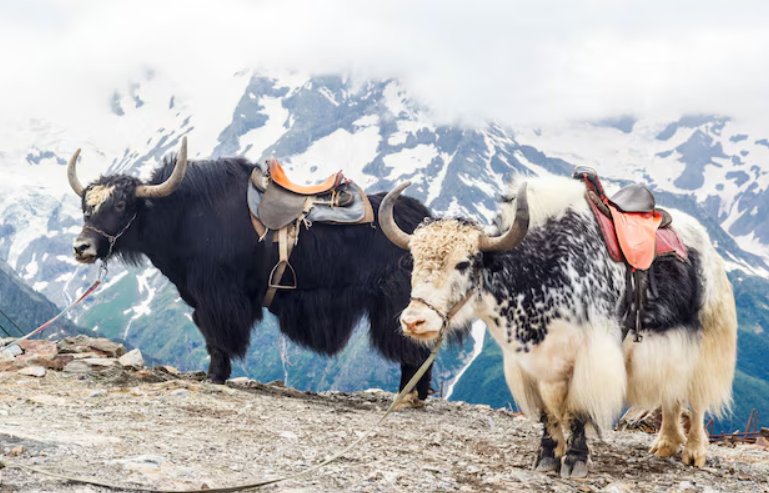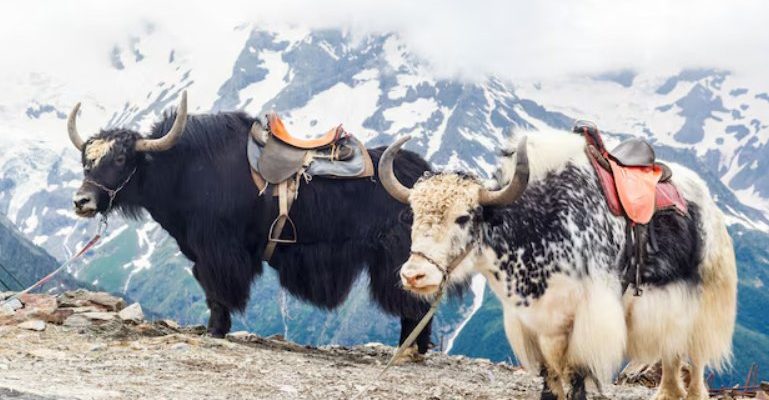
You might be surprised to learn that yaks aren’t just big, shaggy beasts. They’re highly intelligent and have been integral to the lives of the people living in the Himalayas and Tibetan Plateau. Whether used for transportation, milk, or even wool, yaks have a special place in the hearts of many. Here’s a closer look at some incredible facts about these remarkable animals.
1. Yaks Are Built for High Altitudes
One of the most impressive things about yaks is how well they adapt to high altitudes. They typically live at elevations of around 10,000 to 20,000 feet, where oxygen levels can be low. To handle this, yaks have larger lung capacities than most other cattle, allowing them to breathe more efficiently. Their blood is also specially adapted, containing more red blood cells to transport oxygen.
Imagine trying to run a marathon in thin air. For yaks, this is just another day at the office. Their sturdy bodies and powerful limbs help them navigate rugged, rocky terrain with ease. This incredible adaptation makes them one of the few animals capable of thriving in such extreme conditions.
2. They Have a Unique Diet
Yaks are herbivores, which means they munch on plants—primarily grasses, grains, and shrubs. What’s interesting is that they can graze on plants that other animals might find unpalatable, thanks to their specialized digestive systems. Yaks have a complex stomach with four compartments, much like cows, allowing them to break down tough plant material efficiently.
In the wild, yaks are known to forage on the sparse vegetation found in the mountains. They can also survive on lower-quality forage when times are tough. This ability to eat a wide variety of plants not only helps them survive but also makes them valuable for local herders who rely on them for sustenance.
3. Yaks Are Social Animals
If you think yaks are solitary creatures, think again! They are very social animals and prefer to live in herds. Typically, these herds consist of females and their young, while males may roam alone or form bachelor groups. This social structure helps them protect one another from predators, as there’s safety in numbers.
When you watch a yak herd, you’ll see them interacting in various ways. They communicate with each other through vocalizations, body language, and even scents. This social behavior is essential for their survival and fosters strong bonds within the herd.
4. Their Thick Fur Keeps Them Warm
Living in cold, harsh climates means yaks need a way to stay warm, and boy, do they have that covered! Their thick, long fur is a fantastic insulator. The outer layer of hair is coarse and water-resistant, while the undercoat is soft and fluffy, trapping heat.
During winter, some yaks can grow an even thicker layer of fur to cope with the severe cold. This “insulation blanket” allows them to maintain a stable body temperature, even when the temperature plummets. You might say yaks come with their own built-in winter coat!
5. Yaks Provide Many Resources
Yaks are often called “the animal of a thousand uses” due to their incredible versatility. Not only do they provide milk, but their meat, hides, and wool are also highly valued. In many remote communities, yak milk is a staple food source, rich in nutrients and often turned into yogurt or cheese.
Their wool, known as “yak down,” is incredibly soft and warm. It’s often used to make clothing and blankets, perfect for keeping warm in chilly climates. Additionally, yak dung is used as fuel for cooking and heating, making it an essential resource in places where wood is scarce.
6. Yaks Can Actually Swim!
You might think that such heavy, shaggy creatures wouldn’t be great swimmers, but yaks can swim quite well! When needed, they will cross rivers or lakes, using their strong legs to paddle through the water. This ability comes in handy, especially in their mountainous habitats, where rivers can be a barrier to travel.
Just picture a herd of yaks splashing through a river, seemingly unfazed by the water. Their buoyant strength helps them navigate these waters and continue their journey safely. It’s a sight that highlights their adaptability and resilience.
7. They’ve Been Domesticated for Thousands of Years
Yaks have been domesticated for over 4,000 years. They play a vital role in the livelihoods of Tibetan nomads and other communities in the Himalayas. These people rely on yaks for transport, food, and even companionship.
Domestication has allowed yaks to adapt to life with humans, leading to selective breeding for traits like size, temperament, and milk production. This deep-rooted relationship reflects how important yaks are to the culture and economy of the region.
8. They Have Unique Color Variations
When you think of yaks, you likely envision dark, shaggy animals. However, yaks come in various colors, including black, brown, white, and even grey. Some yaks have striking white markings or patches, making them stand out in a herd.
These color variations aren’t just for looks; they can also be indicators of health and adaptability. For example, lighter-colored yaks might be better suited to warmer climates, while darker ones thrive in colder areas.
9. Yaks Have a Low Reproductive Rate
Here’s something to ponder: yaks don’t reproduce as quickly as some other farm animals. A female yak typically gives birth every two years. This slower reproductive rate means that raising yaks is a long-term commitment for herders.
Despite this, the bond between mothers and their calves is strong. A calf stays with its mother for about two to three years, learning essential survival skills during this time. This slower growth also allows herders to manage their herds more sustainably.
10. They Are Symbolic in Many Cultures
In many cultures, yaks are more than just animals; they hold symbolic significance. They’re often seen as symbols of strength and resilience in Tibetan culture. Yaks are also featured in local folklore and myths, representing a connection between humans and nature.
For many communities, the yak embodies the spirit of life in the mountains—surviving against all odds, enduring harsh conditions, and providing for families. This cultural importance further highlights the value of yaks beyond their physical usefulness.
In conclusion, yaks are fascinating animals with incredible adaptations and deep cultural significance. They are a living testament to nature’s ingenuity and the strong bond between humans and animals. So next time you think of yaks, remember—they’re not just fluffy creatures roaming the mountains; they’re vital companions in challenging environments.

